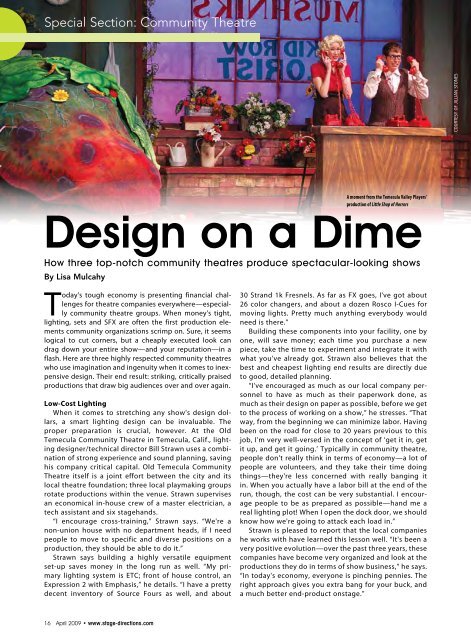Download a PDF - Stage Directions Magazine
Download a PDF - Stage Directions Magazine
Download a PDF - Stage Directions Magazine
Create successful ePaper yourself
Turn your PDF publications into a flip-book with our unique Google optimized e-Paper software.
Special Section: Community Theatre<br />
Courtesy of Jillian Stones<br />
Design on a Dime<br />
How three top-notch community theatres produce spectacular-looking shows<br />
By Lisa Mulcahy<br />
A moment from the Temecula Valley Players’<br />
production of Little Shop of Horrors<br />
Today's tough economy is presenting financial challenges<br />
for theatre companies everywhere—especially<br />
community theatre groups. When money's tight,<br />
lighting, sets and SFX are often the first production elements<br />
community organizations scrimp on. Sure, it seems<br />
logical to cut corners, but a cheaply executed look can<br />
drag down your entire show—and your reputation—in a<br />
flash. Here are three highly respected community theatres<br />
who use imagination and ingenuity when it comes to inexpensive<br />
design. Their end result: striking, critically praised<br />
productions that draw big audiences over and over again.<br />
Low-Cost Lighting<br />
When it comes to stretching any show's design dollars,<br />
a smart lighting design can be invaluable. The<br />
proper preparation is crucial, however. At the Old<br />
Temecula Community Theatre in Temecula, Calif., lighting<br />
designer/technical director Bill Strawn uses a combination<br />
of strong experience and sound planning, saving<br />
his company critical capital. Old Temecula Community<br />
Theatre itself is a joint effort between the city and its<br />
local theatre foundation; three local playmaking groups<br />
rotate productions within the venue. Strawn supervises<br />
an economical in-house crew of a master electrician, a<br />
tech assistant and six stagehands.<br />
“I encourage cross-training,” Strawn says. “We're a<br />
non-union house with no department heads, if I need<br />
people to move to specific and diverse positions on a<br />
production, they should be able to do it.”<br />
Strawn says building a highly versatile equipment<br />
set-up saves money in the long run as well. “My primary<br />
lighting system is ETC; front of house control, an<br />
Expression 2 with Emphasis,” he details. “I have a pretty<br />
decent inventory of Source Fours as well, and about<br />
30 Strand 1k Fresnels. As far as FX goes, I've got about<br />
26 color changers, and about a dozen Rosco I-Cues for<br />
moving lights. Pretty much anything everybody would<br />
need is there.”<br />
Building these components into your facility, one by<br />
one, will save money; each time you purchase a new<br />
piece, take the time to experiment and integrate it with<br />
what you’ve already got. Strawn also believes that the<br />
best and cheapest lighting end results are directly due<br />
to good, detailed planning.<br />
“I've encouraged as much as our local company personnel<br />
to have as much as their paperwork done, as<br />
much as their design on paper as possible, before we get<br />
to the process of working on a show,” he stresses. “That<br />
way, from the beginning we can minimize labor. Having<br />
been on the road for close to 20 years previous to this<br />
job, I'm very well-versed in the concept of ‘get it in, get<br />
it up, and get it going.’ Typically in community theatre,<br />
people don't really think in terms of economy—a lot of<br />
people are volunteers, and they take their time doing<br />
things—they're less concerned with really banging it<br />
in. When you actually have a labor bill at the end of the<br />
run, though, the cost can be very substantial. I encourage<br />
people to be as prepared as possible—hand me a<br />
real lighting plot! When I open the dock door, we should<br />
know how we're going to attack each load in.”<br />
Strawn is pleased to report that the local companies<br />
he works with have learned this lesson well. “It's been a<br />
very positive evolution—over the past three years, these<br />
companies have become very organized and look at the<br />
productions they do in terms of show business,” he says.<br />
“In today's economy, everyone is pinching pennies. The<br />
right approach gives you extra bang for your buck, and<br />
a much better end-product onstage.”<br />
16 April 2009 • www.stage-directions.com

















